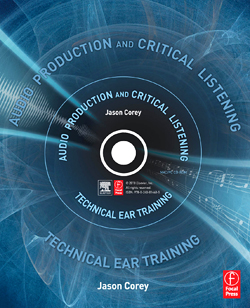From Audio Production and Critical Listening: Technical Ear Training by Jason Corey, published by Focal Press.
In addition to being a utilitarian device for managing the dynamic range of recording media, dynamics processing has become a tool for altering the color and timbre of recorded sound.
When applied to a full mix, compression and limiting can help the elements of a mix coalesce. The compressed musical parts will have what is known in auditory perception as common fate because their amplitude changes share some similarity.
When two or more elements (e.g., instruments) in a mix have synchronously changing amplitudes, the auditory system will tend to fuse these elements together perceptually. The result is that dynamics processing can help blend elements of a mix together.
Here we will move beyond compression as a basic tool for maintaining consistent signal levels to compression as a tool to sculpt the timbre of a track.
Effect of Attack Time
With a compressor set to a long attack time — in the 100-millisecond range or greater — with a low threshold and high ratio we can hear the sound plunge down in level when the input signal goes above the threshold.
The audible effect of the sound being brought down at this rate is what is known as a pumping sound and can be most audible on sounds with a strong pulse where the signal clearly rises above the threshold and then drops below it, such as those produced by drums, other percussion instruments, and sometimes an upright acoustic bass.
If any lower-level sounds or background noise is present with the main sound being compressed, a modulated background sound will be heard. Sounds that are more constant in level such as distorted electric guitar will not exhibit such an audible pumping effect.
Effect of Release Time
Another related effect is present if a compressor is set to have a long release time, in the 100-millisecond range or greater. Listening again with a low threshold and high ratio, be attentive for the sound to come back up in level after a strong pulse.
The audible effect of the sound being brought back up in level after significant gain reduction is called breathing because it can sound like someone taking a breath.
As with the pumping effect, you may notice the effect most prominently on background sounds, hiss, or higher overtones that ring after a strong pulse.
Although compression tends to be explained as a process that it reduces the dynamic range of an audio signal, there are ways to use a compressor that can accentuate the difference between transient peak levels and any sustained resonance that may follow.
In essence, what can be achieved with compression can be similar to dynamic range expansion because peaks or strong pulses can be highlighted relative to quieter sounds that immediately follow them.
It may seem completely counterintuitive to try to think of compressors performing dynamic range expansion, but in the following section we will work through what happens when experimenting with various attack times.




















